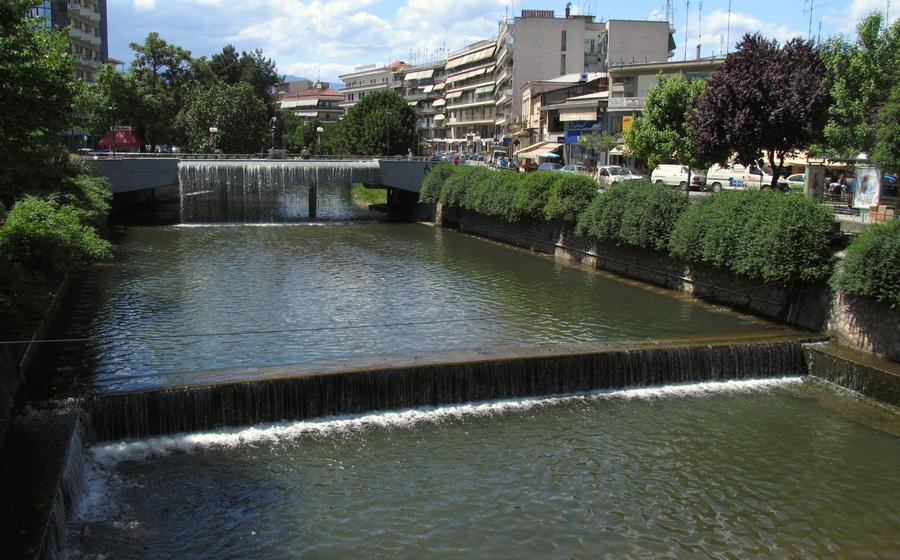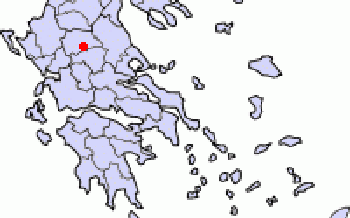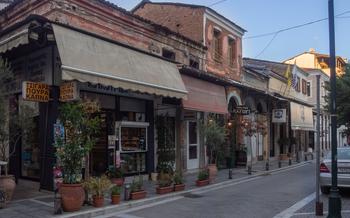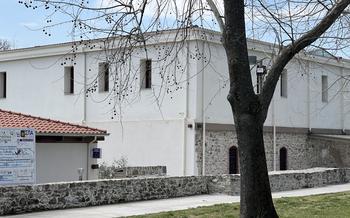
Elafos Natural Habitat
- About Trikala
- The Elafos Natural Habitat
- Visiting the Elafos Natural Habitat
- Activities in the Elafos Natural Habitat
- Wildlife in the Elafos Natural Habitat
- Photography Opportunities
- Accommodations Near the Elafos Natural Habitat
- Restaurants Near the Elafos Natural Habitat
- Souvenirs and Local Products
- Transportation to the Elafos Natural Habitat
- Budgeting for a Visit to the Elafos Natural Habitat
- Health and Safety Considerations
- Ethical Wildlife Viewing
- Fun Facts About the Elafos Natural Habitat
- Insider Tip: Unveiling the Hidden Gem of the Elafos Natural Habitat
About Trikala
Trikala, a captivating city steeped in rich history, lies nestled amidst the verdant Thessalian Plain in central Greece. Its roots can be traced back to ancient times, with evidence of human habitation dating back to the Neolithic period. During the Byzantine era, Trikala flourished as a significant trade and cultural center, leaving behind a legacy of architectural wonders, including the imposing Fortress of Trikala, a testament to the city's resilience and strategic importance.
Trikala's geographical location, at the crossroads of several major routes, has contributed to its diverse cultural heritage, influenced by various civilizations that have graced its lands. Today, the city proudly showcases a harmonious blend of traditional and modern elements, offering visitors a vibrant tapestry of experiences.
The local culture of Trikala is deeply rooted in its history, traditions, and gastronomy. The city's cuisine, a delightful fusion of flavors, reflects the region's rich agricultural heritage. Visitors can savor delectable dishes prepared with fresh, locally sourced ingredients, such as the renowned Trikala sausages, grilled meats, and traditional pies, all complemented by the region's exceptional wines. Whether exploring the city's historical landmarks, immersing oneself in its vibrant cultural scene, or indulging in its culinary delights, Trikala offers an unforgettable journey into the heart of Greece's rich heritage.
The Elafos Natural Habitat
The Elafos Natural Habitat, proclaimed in 1980 and revised in 1995, is situated in the prefecture of Trikala, Thessaly, Greece. This stunning area, covering approximately 3,380 hectares, is a mosaic of habitats, including natural forests, meadows, streams, and a lake, making it a crucial refuge for various wildlife species. The Elafos Natural Habitat is one of the last remaining habitats in Thessaly where one can find the native Greek deer, which have been facing decline due to hunting and habitat loss. The habitat's unique ecological features and diverse wildlife have established it as a significant natural conservation area.
The Elafos Natural Habitat's geographical position and topographical diversity contribute to its ecological richness. In the south, it is bordered by the Agrafa Mountains, while in the north, it opens to the Thessalian plain. The elevation range within the habitat is remarkable, varying from 100 meters near the town of Pyli in the east to 1,600 meters in the Agrafa Mountains in the west. This altitudinal gradient creates distinct microclimates and plant communities that support a wide array of wildlife species. The habitat is home to numerous springs, streams, and seasonal wetlands, providing essential water sources for the resident fauna. The primary forest type in the Elafos Natural Habitat is the mixed oak forest, dominated by Turkey oak (Quercus cerris) and deciduous oak (Quercus frainetto). Other important forest communities include the black pine (Pinus nigra) forests, beech (Fagus sylvatica) forests, and riparian forests along the streams.
The Elafos Natural Habitat is a crucial refuge for many endangered and protected species. The primary focus of conservation efforts is the Greek deer (Cervus elaphus), a species that has faced a significant decline in its population due to hunting and habitat loss. The establishment of the natural habitat has been instrumental in protecting the remaining deer population and promoting its recovery. Conservation efforts also extend to other wildlife species, including wolves (Canis lupus), chamois (Rupicapra rupicapra), wild boars (Sus scrofa), and various bird species, such as eagles, hawks, owls, and songbirds. The habitat's diverse plant communities are also of great importance, providing food and shelter for the resident wildlife.
Visiting the Elafos Natural Habitat
The Elafos Natural Habitat is open to the public year-round, but the best time to visit is during the spring and fall when the weather is mild and the wildlife is most active. The habitat is located just a short drive from the city of Trikala, and there are several ways to get there. You can drive your own car, take a taxi or private transfer, or take public transportation.
If you are driving your own car, take the E92 highway from Trikala towards Kalambaka. After about 15 kilometers, you will see a sign for the Elafos Natural Habitat on the right-hand side of the road. Turn right onto the dirt road and follow the signs for about 2 kilometers until you reach the habitat entrance.
If you are taking public transportation, take the bus from Trikala to Kalambaka. Get off the bus at the stop for the Elafos Natural Habitat and walk the rest of the way. The walk takes about 10 minutes.
Once you arrive at the Elafos Natural Habitat, you will need to purchase a ticket. Tickets can be purchased at the visitor center, which is located at the entrance to the habitat. The visitor center also has a gift shop where you can buy souvenirs, snacks, and drinks.
There are several ways to explore the Elafos Natural Habitat. You can walk along the hiking trails, take a guided tour, or go horseback riding. The hiking trails are well-marked and range in difficulty from easy to challenging. Guided tours are available in English and Greek, and they last for about two hours. Horseback riding tours are also available, and they are a great way to see the habitat from a different perspective.
No matter how you choose to explore the Elafos Natural Habitat, you are sure to have a memorable experience. The habitat is home to a wide variety of wildlife, including deer, birds, and reptiles. You will also be able to enjoy the beautiful scenery and the fresh air.
Activities in the Elafos Natural Habitat
The Elafos Natural Habitat offers a range of activities that allow visitors to fully experience the beauty and diversity of the natural surroundings.
Wildlife Watching: - Observe the various species of deer, including the majestic red deer, the graceful fallow deer, and the elusive roe deer. - Spot other wildlife such as wild boars, hares, foxes, and a variety of bird species. - Learn about the behavior and ecology of these animals through informative guided tours or self-guided exploration.
Birdwatching: - The Elafos Natural Habitat is a haven for bird enthusiasts, with over 150 species recorded. - Observe migratory birds such as storks, cranes, and eagles soaring through the skies. - Spot colorful songbirds, including nightingales, woodpeckers, and finches, in the forest and meadows.
Hiking: - Explore the picturesque trails that wind through the forest, offering stunning views of the surrounding landscape. - Choose from various hiking routes that cater to different fitness levels and interests. - Discover hidden waterfalls, serene lakes, and ancient ruins along the way.
Wildlife in the Elafos Natural Habitat
The Elafos Natural Habitat is renowned for its diverse wildlife, with the star attraction being the majestic red deer, known as elafos in Greek. These elegant creatures roam freely within the protected area, grazing on the lush vegetation and occasionally crossing paths with visitors. The Elafos Natural Habitat is home to a variety of other mammals, including wild boars, foxes, and hares. The skies above are alive with numerous bird species, such as eagles, hawks, and vultures, soaring gracefully on the updrafts. The habitat also supports a rich diversity of plant life, including wildflowers, shrubs, and trees, providing food and shelter for the diverse fauna that call this place home.
The conservation status of the various species within the Elafos Natural Habitat varies. While some, like the red deer, are thriving under the protection of the reserve, others face challenges due to habitat loss and human activities. Conservation efforts are ongoing to ensure the long-term survival of all species within the habitat. Visitors are encouraged to respect the wildlife and their natural behaviors, and to adhere to the guidelines for responsible wildlife viewing to minimize disturbance and contribute to the preservation of this unique ecosystem.
Photography Opportunities
The Elafos Natural Habitat is a photographer's paradise, offering ample opportunities to capture stunning images of the diverse wildlife and landscapes. Here are some tips and tricks to help you make the most of your photography experience:
-
Use a telephoto lens. A telephoto lens will allow you to get close-up shots of the animals without disturbing them. A lens with a focal length of at least 200mm is recommended.
-
Be patient. Wildlife photography requires patience. Be prepared to spend hours waiting for the perfect shot.
-
Use a tripod. A tripod will help you keep your camera steady and avoid blurry photos.
-
Shoot in the early morning or late evening. The light is usually best during these times of day.
-
Look for interesting compositions. Pay attention to the background and foreground of your shots. Try to include elements that will add depth and interest to your photos.
-
Edit your photos. Once you have taken your photos, take some time to edit them. Cropping, adjusting the exposure, and removing distractions can help you create stunning images.
Popular photography spots in the Elafos Natural Habitat include the following:
-
The deer meadow. This is a large open area where you can often see deer grazing.
-
The forest trails. The forest trails offer opportunities to photograph deer, birds, and other wildlife in their natural habitat.
-
The observation tower. The observation tower provides panoramic views of the Elafos Natural Habitat. It is a great place to photograph the surrounding landscape.
If you are interested in learning more about photography, there are several photo editing software programs available, such as Adobe Photoshop and Lightroom. These programs can help you edit your photos and create stunning images.
Accommodations Near the Elafos Natural Habitat
For a comfortable and convenient stay near the Elafos Natural Habitat, several accommodations offer a range of options to suit different preferences and budgets. Here are some recommended hotels and guesthouses:
Hotel Natura: Situated just a short drive from the natural habitat, Hotel Natura offers a tranquil retreat amidst lush greenery. Guests can enjoy modern and well-equipped rooms, a swimming pool, and a restaurant serving delicious regional cuisine.
Elafos Guesthouse: Located within walking distance of the Elafos Natural Habitat, Elafos Guesthouse provides cozy and charming accommodations. Each room features rustic décor, a private balcony, and stunning views of the surrounding landscape.
Villa Artemis: For a luxurious and secluded getaway, Villa Artemis offers exclusive villas with private gardens and pools. Guests can indulge in personalized services, including private chef and concierge services, and relish the breathtaking views of the natural habitat.
These accommodations offer a range of amenities and services to enhance your stay, including comfortable bedding, air conditioning, Wi-Fi, and parking. To ensure availability and secure the best rates, it is advisable to book your accommodations in advance, especially during peak tourist seasons.
Restaurants Near the Elafos Natural Habitat
After a long day of exploring the Elafos Natural Habitat, you'll surely work up an appetite. Fortunately, there are several excellent restaurants nearby where you can savor the local cuisine and specialties.
One highly recommended restaurant is To Steki tou Ilia, situated a short drive from the natural habitat. This traditional Greek tavern serves up mouthwatering dishes prepared with fresh, local ingredients. Indulge in their signature Kleftiko (slow-cooked lamb) or sample their delicious seafood platter.
For a taste of modern Greek cuisine with a twist, head to To Kafeneio, located in the charming village of Elati. Here, you'll find innovative dishes that showcase the region's flavors in a contemporary style. Try their grilled octopus with fava beans or the slow-cooked pork belly with honey and thyme.
If you're looking for a casual dining experience, To Souvlatzidiko tou Nikou is a great option. This family-run restaurant specializes in traditional Greek souvlaki and gyros. Their juicy skewers are cooked to perfection and served with fresh-cut fries and tzatziki sauce.
No matter which restaurant you choose, be sure to ask for recommendations from the friendly staff. They'll gladly help you navigate the menu and make sure you have a memorable dining experience.
Insider Tip: For a truly unique culinary experience, try one of the local restaurants that offer traditional Greek cooking classes. You'll learn how to prepare classic dishes like moussaka, pastitsio, and spanakopita, and you'll get to savor the fruits of your labor afterward.
Souvenirs and Local Products
The Elafos Natural Habitat is rich in unique souvenirs and local products that visitors can take home as mementos of their visit. Traditional crafts and arts are particularly popular, with many local artisans selling their wares at the habitat's visitor center and in nearby shops. These include hand-woven rugs, pottery, jewelry, and wood carvings, each piece showcasing the region's rich cultural heritage.
One of the most popular souvenirs is the hand-crafted pottery, which is made using traditional techniques that have been passed down for generations. Visitors can choose from a wide variety of pottery items, including plates, bowls, vases, and figurines, each with its own unique design and glaze.
Another popular souvenir is the hand-woven rugs, which are made from locally-sourced wool and feature intricate patterns and designs. These rugs are not only beautiful but also durable, making them a practical and stylish addition to any home.
For those who love jewelry, there is a wide selection of handcrafted pieces made from silver, gold, and semi-precious stones. These pieces are often inspired by ancient Greek designs and feature intricate details and craftsmanship.
Finally, don't forget to try the local honey, which is produced by bees that feed on the nectar of the wild flowers in the Elafos Natural Habitat. This honey is known for its rich flavor and aroma, making it a delicious and healthy souvenir to take home.
Transportation to the Elafos Natural Habitat
The Elafos Natural Habitat is easily accessible by car, public transportation, or taxi.
By car: The habitat is located just a short drive from the city of Trikala. Simply follow the signs to the village of Elafos, and then follow the road for about 5 kilometers until you reach the entrance to the habitat.
By public transportation: There is a bus that runs from Trikala to Elafos several times a day. The bus stop is located near the train station in Trikala. The journey takes about 30 minutes, and the fare is very reasonable.
By taxi: If you prefer to travel by taxi, you can easily hail one in Trikala. The fare to the Elafos Natural Habitat is typically around 15 euros.
Once you have arrived at the Elafos Natural Habitat, there are several parking areas available. The parking is free of charge, and there are plenty of spaces available.
Budgeting for a Visit to the Elafos Natural Habitat
Visiting the Elafos Natural Habitat can be a budget-friendly experience with a little planning and flexibility. Accommodations near the habitat range from budget-friendly guesthouses to mid-range hotels. Expect to pay around €20-€30 per night for a basic room or €50-€100 for a more comfortable stay. Food is another area where you can save money by packing your own snacks and lunches or opting for budget-friendly local restaurants. Expect to spend around €10-€20 per day on meals, depending on your eating habits. Activities are generally affordable, with guided tours ranging from €10 to €20 and wildlife watching or birdwatching excursions starting at around €
To save money, consider visiting during the shoulder seasons (spring or fall) when prices are lower and there are fewer crowds. You can also save money by cooking your own meals, taking advantage of free activities like hiking, and looking for discounts or package deals. When budgeting, be sure to factor in transportation costs, which can vary depending on whether you rent a car or use public transportation.
Ultimately, the cost of your trip will depend on your travel style and preferences. With a little planning and flexibility, you can easily enjoy a memorable and affordable visit to the Elafos Natural Habitat.
Health and Safety Considerations
When planning a trip to the Elafos Natural Habitat, packing essentials for your well-being is crucial. Ensure you bring comfortable and weather-appropriate clothing, sturdy hiking shoes, a hat, and sunglasses to protect yourself from the sun. Insect repellent and sunscreen are also essential for keeping away pesky insects and shielding your skin from harmful UV rays.
As you explore the natural habitat, be mindful of potential health risks and take necessary precautions. The area is generally safe, but it's advisable to stay on designated trails to avoid encountering wildlife or getting lost. If you have any underlying health conditions, consult your doctor before embarking on the trip. It's also wise to carry a basic first-aid kit for minor injuries or ailments.
In case of an emergency, several hospitals and clinics are located within a reasonable distance from the Elafos Natural Habitat. Keep their contact information handy and ensure you have travel insurance that covers medical expenses. It's also essential to be aware of local emergency numbers and how to contact them in case of an emergency.
Ethical Wildlife Viewing
When visiting the Elafos Natural Habitat, it's crucial to prioritize ethical wildlife viewing practices to minimize disturbance to the animals and their natural habitat. Here are some guidelines to follow:
-
Respectful Observation: Maintain a safe distance from the animals and avoid approaching them too closely. Use binoculars or a telephoto lens for a closer look without causing distress.
-
Quiet Behavior: Keep noise levels low and avoid sudden movements or loud noises that might startle the animals.
-
Stay on Designated Trails: Stick to designated trails and avoid venturing off-track to prevent disturbing sensitive areas or vegetation.
-
Avoid Feeding: Refrain from feeding the animals, as this can disrupt their natural feeding habits and potentially lead to health issues.
-
Minimize Your Impact: Leave no trace of your visit by properly disposing of waste and avoiding littering.
-
Support Conservation Efforts: Consider donating to or volunteering with local conservation organizations that work to protect the Elafos Natural Habitat and its wildlife.
By following these guidelines, you can contribute to the conservation of this unique ecosystem while having a memorable and enriching wildlife viewing experience.
Fun Facts About the Elafos Natural Habitat
The Elafos Natural Habitat boasts a plethora of intriguing characteristics and historical significance that make it a captivating destination. Here are a few fun facts to enhance your visit:
-
Archaeological Discoveries: The area surrounding the Elafos Natural Habitat has yielded significant archaeological finds, including ancient artifacts and ruins from various civilizations that once inhabited the region.
-
Legendary Creatures: According to local folklore, the Elafos Natural Habitat is believed to be the home of mythical creatures such as centaurs and nymphs, adding an air of enchantment to the site.
-
Tree of Life: Within the habitat, visitors can marvel at the majestic "Tree of Life," an ancient oak tree that is considered sacred by the local community. It is believed to bring good fortune and blessings to those who touch its bark.
-
Unique Plant Species: The Elafos Natural Habitat is home to a diverse range of flora, including rare and endangered plant species that thrive in its unique microclimate. Botanists and nature enthusiasts can embark on a journey of discovery, identifying and appreciating these remarkable plants.
-
Wildlife Photography Haven: The habitat's rich biodiversity and stunning landscapes make it a paradise for wildlife photographers. With patience and skill, visitors can capture breathtaking images of deer, birds, and other creatures in their natural environment.
Insider Tip: Unveiling the Hidden Gem of the Elafos Natural Habitat
Nestled within the heart of the Elafos Natural Habitat, there lies a hidden gem waiting to be discovered - the secluded Whispering Falls. Tucked away from the usual tourist trails, this enchanting waterfall offers a tranquil oasis of natural beauty. As you approach the falls, the gentle sound of cascading water fills the air, creating a mesmerizing ambiance. Surrounded by lush greenery and towering trees, the falls provide a perfect spot for a peaceful picnic or a refreshing dip in the crystal-clear pool below. For an unforgettable experience, visit the Whispering Falls at dawn or dusk, when the soft light casts a magical glow on the surroundings, turning the entire scene into a breathtaking masterpiece. Whether you choose to bask in the tranquility of the falls or capture its beauty through your lens, the Whispering Falls promises an unforgettable encounter with nature's wonders.









